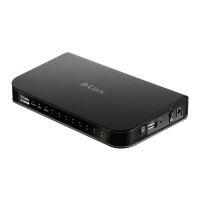D-Link DSR-Series User Manual 164
Section 8 - Security
Path: Security > Authentication > External Auth Server > LDAP Server
The LDAP authentication method uses LDAP to exchange authentication credentials between the router and an
external server. The LDAP server maintains a large database of users in a directory structure, so users with the
same user name but belonging to dierent groups can be authenticated since the user information is stored in
a hierarchal manner. Also of note is that conguring a LDAP server on Windows or Linux servers is considerably
less complex than setting up NT Domain or Active Directory servers for user authentication.
The details congured on the controller will be passed for authenticating the router and its hosts. The LDAP
attributes, domain name (DN), and in some cases the administrator account & password are key elds in allowing
the LDAP server to authenticate the controller.
To congure the router to connect to your LDAP server:
1. Click Security > Authentication > External Auth Server > LDAP Server tab.
LDAP Server
Field Description
Server Checking Click it to test the connection(s) to your LDAP Server(s).
Authentication Server
(1-3)
Enter the IP address of your primary LDAP server.
LDAP Attribute (1-4)
These are attributes related to LDAP users congured in LDAP server. These may include attributes like
SAM account name, associated domain name etc. These can be used to distinguish between dierent
users having same user name.
LDAP Base DN Enter the base domain name.
Timeout Set the amount of time in seconds that the router should wait for a response from the LDAP server.
Retries This determines the number of tries the controller will make to the LDAP server before giving up.
Save Click Save at the bottom to save and activate your settings.
Administrator Account
Enter the admin account information that will be used when LDAP authentication is required for PPTP/
L2TP connection.
Password Enter the admin password.
Save Click Save to activate your settings.
2. Complete the LDAP server information from the table below and click Save. You can congure up to
three servers.

